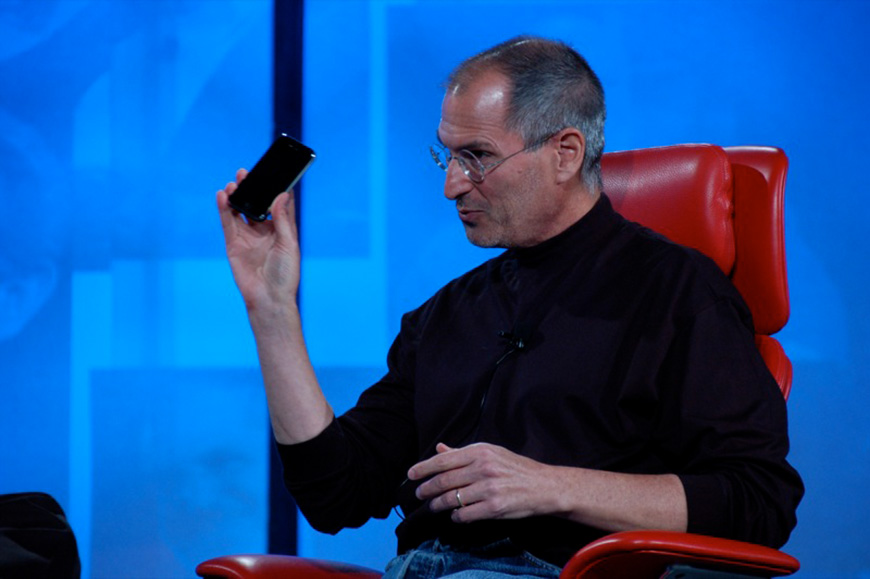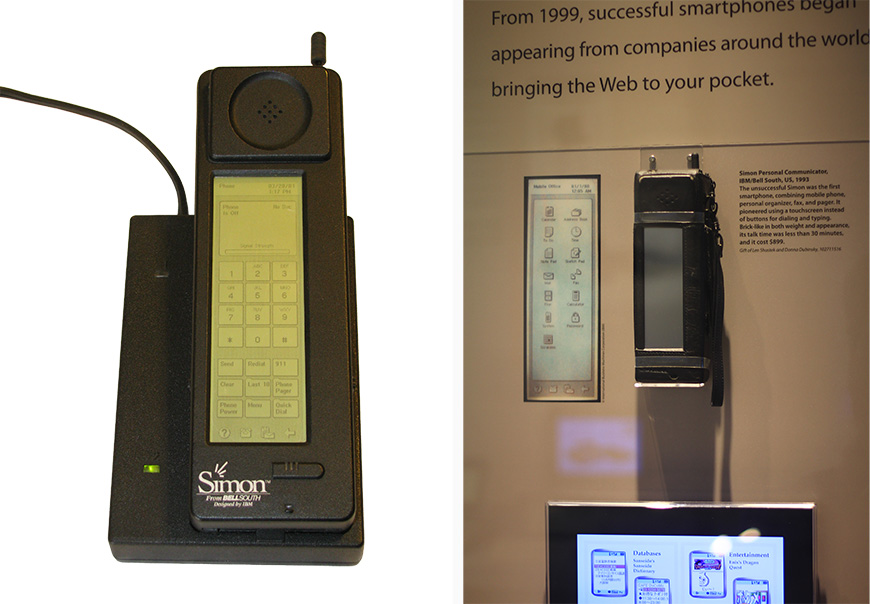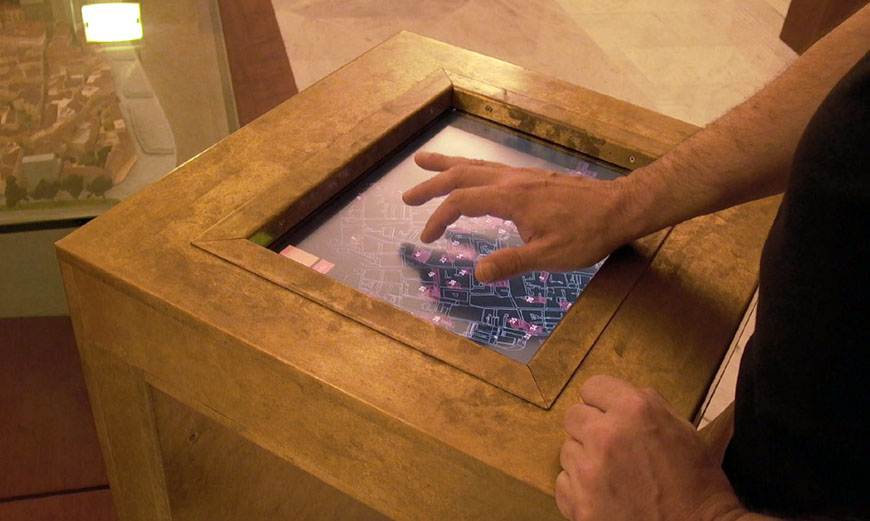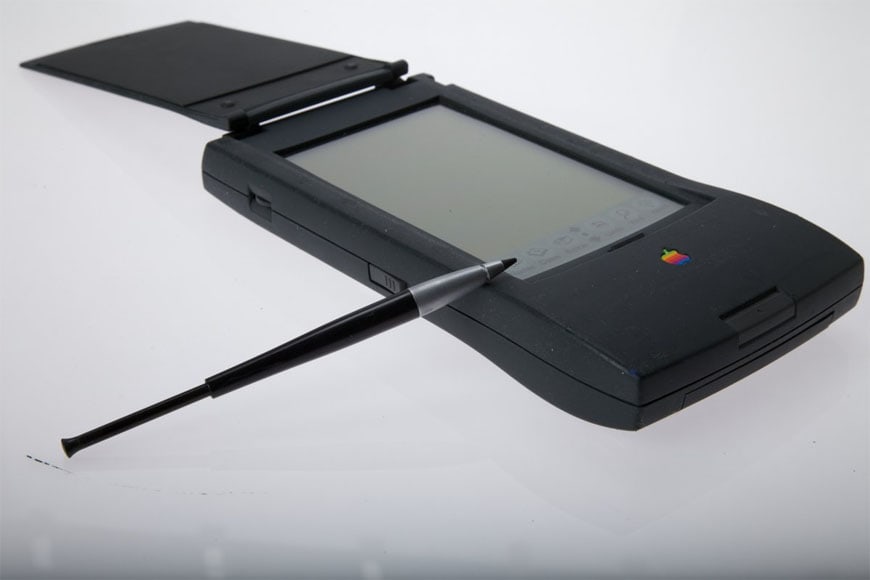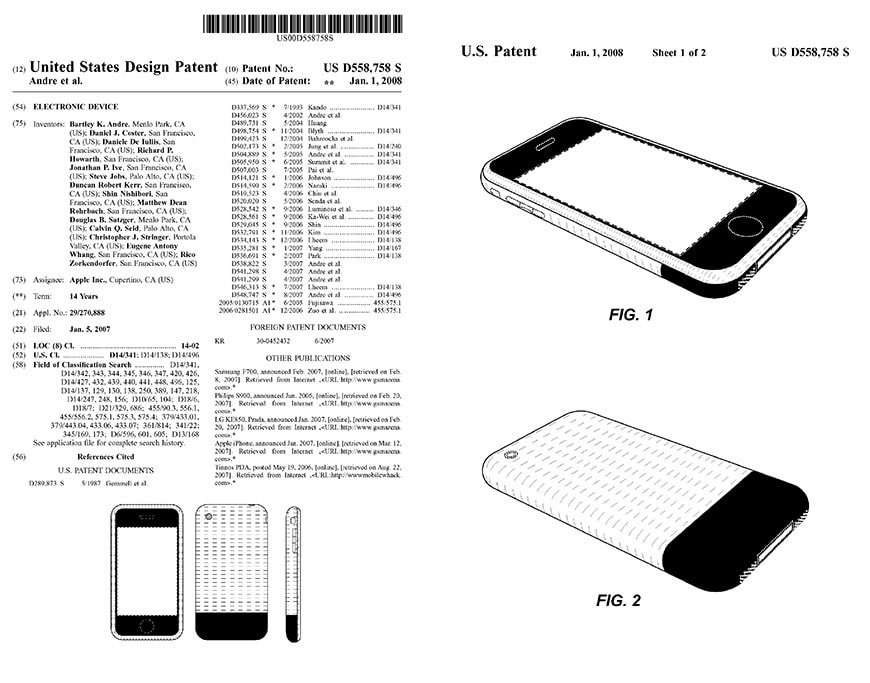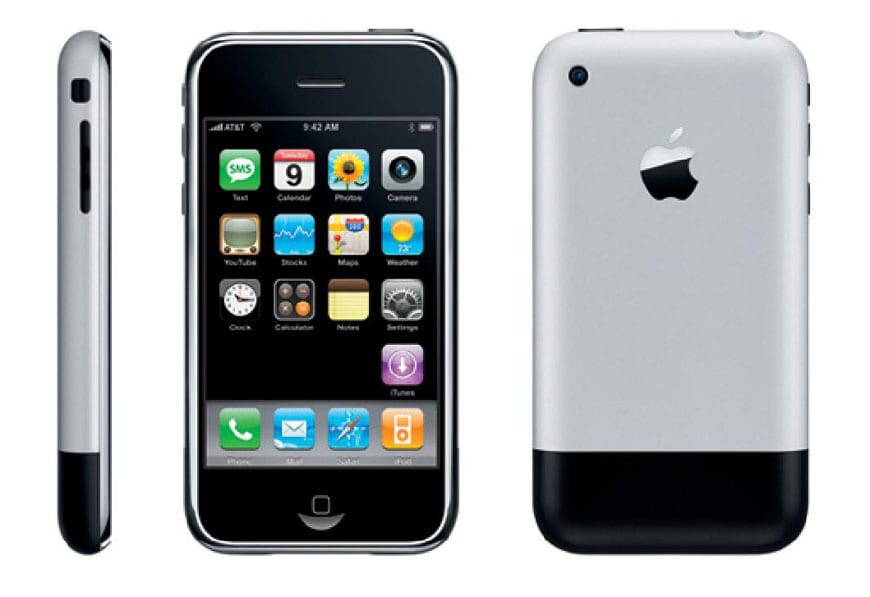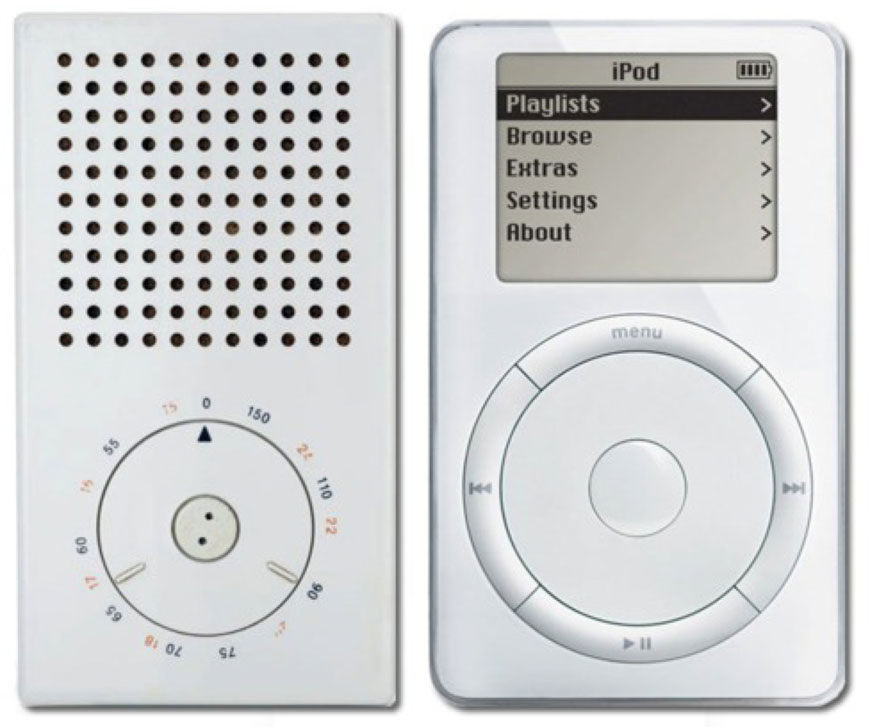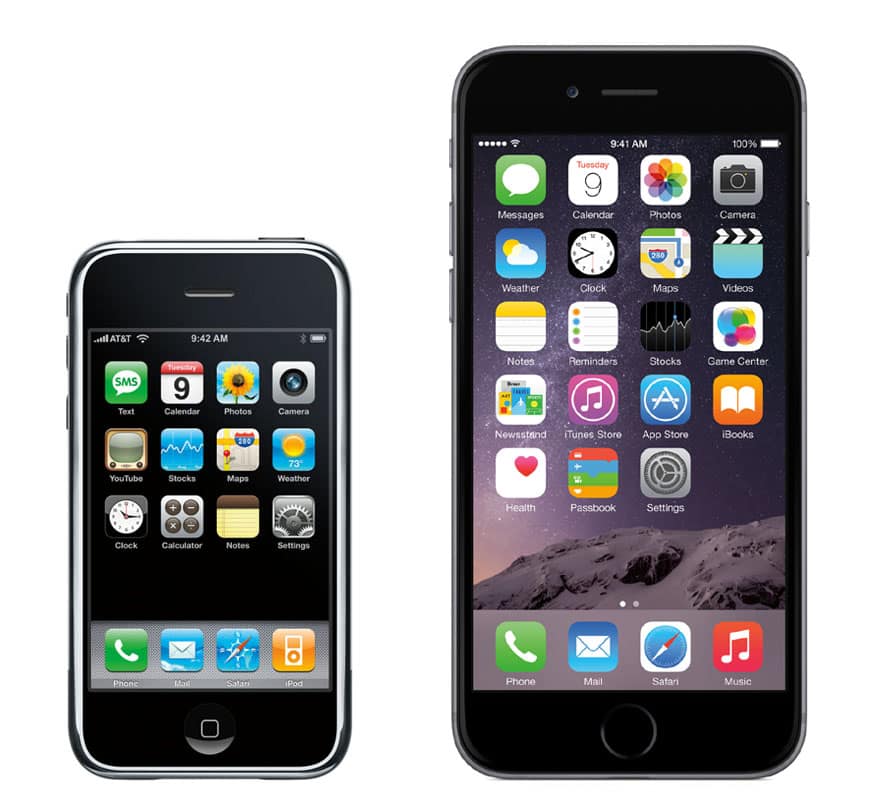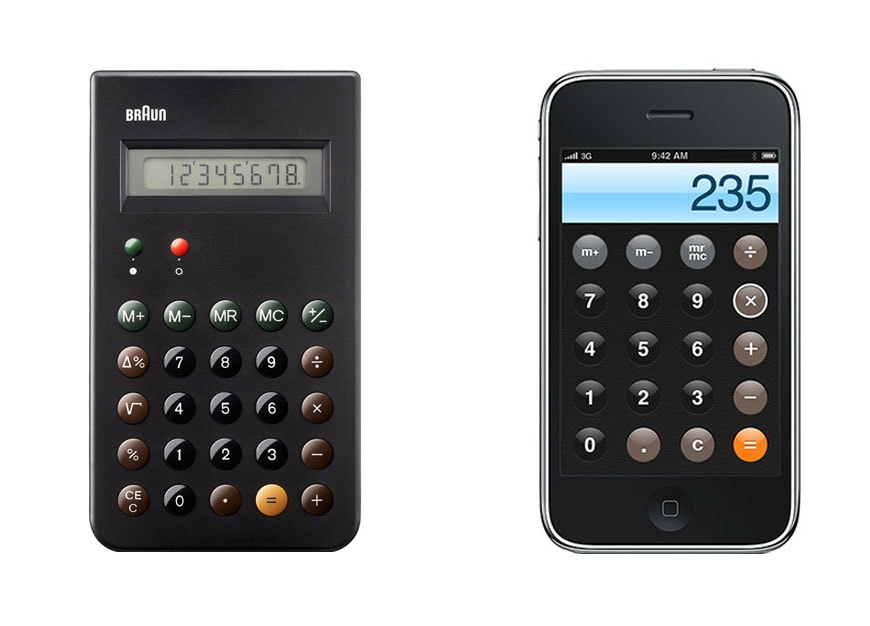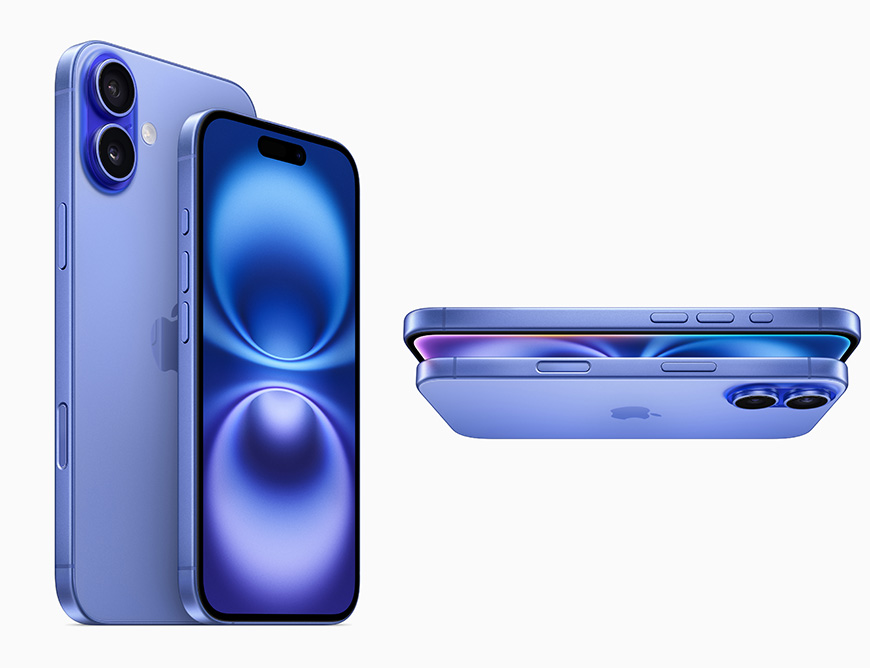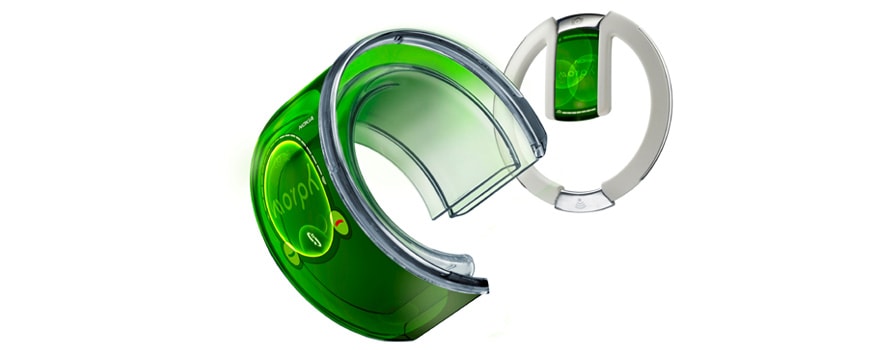History and design of the Apple iPhone
Steve Jobs holds up his iPhone at the D5 Conference on May 30, 2007; photo by David Geller (CC BY 2.0) via Flickr.
History and design of the Apple iPhone
Introduction
When Steve Jobs presented the first iPhone at San Francisco’s Moscone Center on January 9, 2007, many of Apple’s competitors were taken aback.
Until then, RIMS’ BlackBerry devices dominated the high-end mobile phone market. Aimed at businessmen and creative professionals, the keys to their success were relatively large and complete (considering the device’s size) integrated QWERTY keyboards with which writing and exchanging e-mails, SMS, and short texts with the rest of the world was much easier than with most ordinary, and cheaper, mobile phones of the time.
Therefore, it’s easy to imagine how big a surprise it was to see Jobs presenting a device with no physical keyboard, replaced by an enormous (at least back in the day) 3.5” touchscreen enclosed by a thin aluminum and black plastic frame.
From a telephone to (almost) a computer
Using touchscreens to combine interaction and visualization into a single device was not a novelty. It was indeed a solution already adopted, for example, in state-of-the-art exhibition design, to provide a more natural interaction and access to content for the heterogeneous assortment of people, from children to octogenarians, who frequent museums and exhibitions. Nevertheless, before 2007, this technology was only marginally implemented in a small device that many still considered essentially just a telephone.
For truth’s sake, in 1994, IBM released a “monumental” touch-only mobile phone, the Simon Personal Communicator, an eight-inch-long object weighing approximately 18 ounces; yet, the Simon had a brief and ephemeral success, lasting just six months.
Released in 1994, the IBM Simon was the first touchscreen-only mobile phone. Despite its modest success, it is generally regarded as the precursor of all smartphones. Photos by Bcos47 (left, Public Domain) and Michael Hicks (right, CC BY 2.0) via Wikimedia Commons.
A touchscreen-based interactive exhibit in a museum, 2002, photo Bianchini & Lusiardi Architects
Apple’s idea was to use the phone’s display, a capacitive touchscreen that could be used with the bare fingers, as its main input device; thus completely removing the physical keyboard and maximizing the size of the display to improve the user’s experience and provide a portable device suitable for full video reproduction, music listening, digital entertainment, web navigation, GPS, and so on; essentially transforming a phone into a miniaturized mobile computer, albeit quite limited in many functions (I will discuss this point later).
Apple and its most talented designer, Jonathan “Jony” Ive (b. 1967), have been working on keyboard-less touchscreen-based mobile devices since the late 1980s, with conceptual designs such as the Macintosh Folio and the unlucky Apple Newton, released in 1993.
Yet, those early projects failed, mainly because touch-screen technology and the computational power of small microprocessors were poor at the time; for example, the Apple Newton still required a stylus pen and lacked sufficient graphics performance to be more than a nice Personal Digital Assistant.
The Apple Newton, the first product designed by Jonathan Ive in Cupertino, 1993, photo Jim Abeles (CC BY-NC-ND 2.0) via Flickr
A decisive step was taken in the early 2000s, after Steve Jobs’ return to the helm of Apple in 1997. Jobs realized the potential of keyboard-less, multi-purpose mobile devices and started devising a way “to put a great computer in a book that you can carry around with you and learn how to use in 20 minutes.“ This would later become the iPad, yet Jobs decided to release a mobile telephone first.
Is the iPhone a computer?
No, despite what Jobs said, it isn’t.
It’s not a matter of computational power; an iPhone 16 is a hundred times more powerful than the Pentium-based PC I used in the mid-’90s for (not too complex) 3D modeling and full-res video editing. The problem is the human-computer interaction; the display of a smartphone is just too small and its input system (the display itself) is too limited in its capabilities to make the iPhone a device apt for professional applications, such as a true photo-editing software like Photoshop, CADs, or even a basic word processor.
Therefore, it makes no sense to use an iPhone (and even an iPad, to some extent) at work, other than as a device to navigate the internet, a point-and-shoot photo camera, or a tool to write a simple 100-word text. Of course, you can do some professional work with it – for over three decades, Andy Warhol took magnificent photos with a rather basic Polaroid film camera -, but you can’t run a single professional software on a smartphone and even if you could theoretically install Photoshop on an iPhone, using it proficiently would be out of the question, due to the tiny screen and the intrinsic limitation of touchscreens as an input device when great precision is required.
Now, I should point out what is, in my opinion, a computer. Dropping the obsolete distinction between personal computers and workstations, which became obsolete after the end of the workstation era in the early 2000s, a general-purpose computer is an affordable electronic device—you can use it at home or for work, indifferently—that can seamlessly run a broad range of software applications, including professional ones.
This was the conceptual backbone of the digital revolution that, during the ’80s, made computational power accessible to (almost) all in the Western world, moving computers from high-end research laboratories to our homes. A revolution that Steve Jobs and Steve Wozniak also contributed to sparking.
Smartphones are essentially portable communication and entertainment devices, and, as long as their physical limitations are not overcome, they will always be no more than that. This isn’t necessarily bad, as long as you know it.
I suspect that Jobs was perfectly aware of that and that his definition of “a great computer” was more marketing than a real conviction. Indeed, you can’t honestly learn to use a “real” computer in twenty minutes.
Jonathan Ive and the design of the iPhone
The iPhone project was started in 2004 with the codename “Project Purple”.
Conceptual sketches of the first iPhone, created by Jonathan Ive and the Apple design team, reveal a device remarkably similar to the final product, albeit with a slightly more rounded edge and a slightly smaller display.
The first iPhone was a small device, shaped like a block of bar soap and weighing 135 grams. Besides the glass screen, the phone’s chassis, mostly made of aluminum, “embraced” the display to protect it from accidental side impacts.
The original patent request for an “electronic device”, submitted by Apple on January 1, 2008. Image source: United States Patent and Trademark Office
A large round menu button was the only visible physical input device on the front. There were four other buttons on the phone’s sides to regulate volume, control phone calls, mute the phone’s ringing, and perform other functions.
Since the phone didn’t have a lid or a cover, a proximity sensor was added to inactivate the touch function when the user brought it close to their head during a call. Other sensors – including an accelerometer and, later, a gyroscope – were necessary to register the device’s movements and relative orientation in space.
A first-generation Apple iPhone, image courtesy of Apple Inc.
Ive has never denied the influence German designer Dieter Rams had on him.
With a creative background based on the functional design developed at the Bauhaus school in the early decades of the 20th century, Rams (b. 1932) is famous for the products he conceived for the German company Braun during the Fifties, the Sixties, and the Seventies; as well as for his academic work at the Ulm School of Design (Hochschule für Gestaltung Ulm), including the development of his Ten Points of Good Design, before the school closed in 1968.
“Good design is innovative. Good design must be useful. Good design is aesthetic design. Good design makes a product understandable. Good design is honest. Good design is unobtrusive. Good design is long-lasting. Good design is consistent in every detail. Good design is environmentally friendly. And last but not least, good design is as little design as possible” (The Ten Points of Good Design by Dieter Rams)
There is little doubt that Braun’s designs and principles influenced the unique design of many of Apple’s products, such as the iPod, iPad, iMac, Mac Pro, and, of course, the iPhone.
Left: Braun T3 pocket radio, 1958; right: a first-generation Apple iPod, 2001
Dieter Rams in 2024; photo by Ifdesigncommunication via Wikimedia Commons (CC BY-SA 4.0)
However, due to its apparent simplicity, Ive’s iPhone was possibly less good at expressing the influence of Rams’ design than the iPod, for example. Nevertheless, it was perfect for showcasing some of his ten principles.
A device in which the complexity of the visible physical component was reduced to a minimum was indeed an ideal “playground” to push conceptual points such as detail consistency and the exhibition of “as little design as possible” to an unprecedented level in a consumer electronic product, even for a design-oriented manufacturer like Job’s Apple.
“Steve and I spent months and months working on a part of a product that, often, nobody would ever see, nor realize was there” (Jonathan Ive)
The son of a British silversmith, Ive bases his approach to industrial design on a profound knowledge of manufacturing processes as much as he does on pure design skills. When you push the apparent simplicity of an object to that extent, God is even more in the details.
“Objects and their manufacture are inseparable. You understand a product if you understand how it’s made” (Jonathan Ive)
“When you think about your iPhone, it’s probably the object that you use most in your life. It’s the product that you have with you all the time. Along with the experience of actually using it, what makes iPhone 5 so unique is how it feels in your hand, the material it’s been made with, the remarkable precision with which it is built.” (…)
“The body is made from a single piece of machined aluminum. The whole thing is polished first to a mirror finish and then is very finely textured, except for the Apple logo. The chamfers are cut with diamond-tipped cutters. The cutters don’t usually last very long, so we had to figure out a way of mass manufacturing long-lasting ones. The camera cover is sapphire crystal. Look at the details around the SIM card slot. It’s extraordinary!” (Ive talking about the iPhone 5 in 2010)
Interaction design and the “skeuomorphic” graphic interface
Developing a technically innovative product was a demanding effort that required combining a completely new physical design with a revolutionary user interface for a mobile phone, with many similarities to contemporary desktop and laptop computers.
The concept beyond the iPhone UI was that you need different inputs depending on the applications you are using, therefore a fixed physical keyboard is too functionally rigid and space-wasting for a smartphone; it would be much better to replace it with a flexible “virtual” interface which adapts to the user’s needs and behaviors.
This was already achieved in desktop computers, with an icon-based graphic interface and a mouse, but in the iPhone, the mouse was replaced by a touchscreen. Furthermore, the “large” size of the display allowed the use of applications, such as the Safari internet browser, almost identical to those installed in full-size computers (hitherto, smartphones included very simplified “baby” web browsers).
The operating system was a stripped-down version of the OS X Apple used in its PowerPC computers. Yet, the iPhone’s peculiar input system required the development of a completely new gesture-based interface and innovative solutions such as the multi-touch technology we are accustomed to today.
iPhone’s multi-touch and multi-finger gesture sequence, image courtesy of Apple Inc.
The graphic design of the iPhone interface was based on those principles of skeuomorphism.
All digital interfaces Apple developed since the introduction of the Macintosh featured graphic elements mimicking real-life ones: a digital clock looking like a good old alarm clock, the camera icon resembling a glass lens, the icon of the digital newspapers’ folder evoking a wooden bookcase, and so on. This is skeuomorphism, and Steve Jobs liked it, deeming it more “natural” and intuitive for most users, at least during the transition from an analog to a digital society.
Comparison between the home screens (also known as “springboard” ) of the OS1 (left, 2007) and OS9 in a 6 Plus (right, 2014); images courtesy of Apple Inc.
Yet, Ive never refused to admit he dislikes skeuomorphism and subtly introduced a cleaner graphic style in elements such as the iPhone’s calculator, which is again a tribute to Rams’ Braun ET44 and ET66 pocket calculators. More recently, especially since the release of IOS 7, Apple has been inclined to abandon skeuomorphism for a more essential and “flat” graphic design.
left: Braun ET66 pocket calculator (1987); right: calculator app in the iPhone (2007)
The evolution of the iPhone design from the first generation to the 16th generation
Over time, even innovative designs must evolve, especially in a competitive market like consumer electronics.
Yet, the iPhone substantially retained the basic elements conceived by Jobs and Ive in the early 2000s. Of course, compared to the first generation, the iPhone 16 is thinner, more powerful, more affordable, has superior graphics, has much greater hardware capabilities, and is easier to use.
Nevertheless, it is, to a large extent, the same design as the 2007 model.
From this point of view, the biggest difference is that the iPhone 16 is much larger, 6.7” versus the first generation’s 3.5”. There has been a great debate about this larger size, which seems to contradict Job’s idea of a little, simple, and handy device.
Yet, in my opinion, it is a natural and coherent evolution of the iPhone’s initial concept. Indeed, if you turn a phone into a multi-purpose and multi-media device, the screen size must be as large as possible to provide the user with a satisfying experience. Additionally, from a commercial point of view, it’s a matter of fact that larger devices have a stronger visual impact than smaller ones when placed side by side in a shop’s display.
The 6.1” iPhone 16 and the 6.7” iPhone 16 Plus, images courtesy of Apple Inc.
When less is much less
The history of the iPhone project raises serious questions on the evolution of consumer electronics’ design and, more generally, on what it means to be a designer today.
If the first-generation iPhone was the perfect embodiment of Ram’s principle that “good design is as little design as possible”, at the same time a device that, from a user’s point of view, largely coincides with its display doesn’t leave much room for evolution, at least of the object’s physical component.
You can use better materials, make it thinner and lighter, more durable and robust, but not much more.
The key points of such an object’s design were transferred into its display and under its virtual hood in the instant it was imagined for the first time.
In this case, the design of the graphic interface and gesture recognition – and more generally what we may call the “immaterial” design – is as important, if not more important, than the design of the physical object.
copyright Inexhibit 2025 - ISSN: 2283-5474

